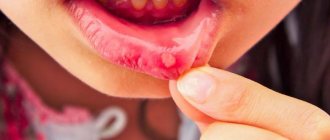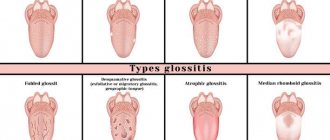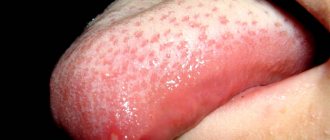Content:
- Description of the disease
- Manifestations of the disease
- How does allergic stomatitis develop?
- Why does it occur
- Establishing diagnosis
- Fighting the disease
- How to reduce the risk of developing the disease
A dental disease in which the integrity of the oral mucosa is damaged - allergic stomatitis - occurs quite often in medical practice. It comes in different forms, so a person cannot always understand what caused the disease and what factors caused its negative symptoms.
Causes of an allergic reaction
Allergies manifest themselves when the oral mucosa is exposed to certain substances that make up crowns, fillings, dentures, and braces.
The disease can be the result of taking medications, especially antibiotics and sulfonamides.
Sometimes the cause of allergic stomatitis is food products (spicy seasonings, citrus fruits), dust particles, and insect bites.
May be a manifestation of systemic diseases: angioedema, hemorrhagic diathesis, exudative erythema, systemic lupus erythematosus, Lyell's disease, Behçet's syndrome.
The risk of developing allergic stomatitis increases with weakened immunity.
Description of the disease
With the diagnosis described, the oral mucosa is damaged, the tissues become very susceptible to all irritants. The incubation period is long. This means that a lot of time passes from the moment the first signs of allergy appear to the manifestation of the disease itself. Because of this, the patient is unable to track the relationship between the symptoms that bother him.
Allergic stomatitis occurs in both children and adults. More often it is diagnosed in people who live in areas with unfavorable environmental conditions.
Children and herpetic stomatitis
In childhood, the disease is more severe than in adults, and begins with a sharp increase in body temperature (38°C or more). The child's lymph nodes enlarge, the baby becomes irritable and is capricious a lot.
Stomatitis is detected after examination by an oral cavity specialist: the gums become swollen, take on a bright red tint and constantly bleed; rashes appear on the second or third day of the disease.
From time to time, the child may have his mouth slightly open, from which saliva flows, and it is painful for him to swallow.
When examining the baby's mouth area, grouped blisters are observed. Please note that the bubbles open after a while, which is accompanied by pain in the child’s mouth, he refuses to eat, cries constantly and sleep is disturbed.
The erosions that form in the mouth will gradually become covered with a white coating, and after a few days, the mucous membrane will clear up and heal.
In children, the disease manifests itself in different stages.
In mild cases of herpetic stomatitis, rashes appear exclusively in the oral cavity; treatment at home is allowed (be sure to call a doctor).
Moderate and severe degrees of the disease are characterized by rashes not only in the oral cavity, but also in the mouth area. Children aged 1 to 4 years should be hospitalized in any case.
A child with acute herpetic stomatitis must be isolated in a separate room, which should have low lighting (bright light will irritate the patient).
The child should be provided with separate dishes.
Manifestations of the disease
The disease negatively affects the functioning of the entire body. It doesn’t just cause inflammation of the mucous membranes—it also causes migraines, elevated body temperature, and lethargy. Many people notice dry mouth, severe pain when chewing, which is present even when the integrity of the tissues has not yet been compromised.
Saliva thickens, becomes viscous, more like foam. The gums, tongue, and inner surface of the cheeks may swell. All these symptoms deprive the patient of the opportunity to lead a normal lifestyle.
You shouldn’t wait for the disease to clear up. The sooner her treatment is started, the sooner her health will be normalized.
How does allergic stomatitis develop?
Dentists distinguish three stages of the disease:
- Primary or catarrhal. A person notices a burning sensation in the mouth, drying out of the mucous membranes. There are no ulcers or plaque yet or they are barely noticeable. If treatment is not started, the resulting ulcers will begin to grow.
- Bullous. Bubbles form on the tissues. There is a cloudy liquid inside them.
- Ulcerative-necrotic. The most dangerous stage in the development of pathology. The pain in the mouth becomes very strong, acute, and does not go away even during rest. The mucous membranes of the mouth swell, turn red, and look inflamed. Numerous ulcers are visible on them, covered with a dense gray coating. If you try to remove the top film, the wound begins to bleed.
You can't start a disease. It is much more difficult to treat the ulcerative-necrotic form of stomatitis than the catarrhal form.
Why does it occur
From the name of the disease it is clear that it is allergic in nature. The disease develops in two cases:
An allergen enters the patient's body. As a result, a pathological response of the immune system develops. We are talking about allergies to pollen, medications, mold, and food.- The tissues of the oral cavity come into direct contact with the allergen. This means that the oral cavity has been treated with something (for example, a medicinal composition, toothpaste, mouthwash) or some kind of dental structure has been installed.
Most often, allergic stomatitis is a consequence of individual intolerance to the materials used by the dentist. Thus, many people are allergic to application solutions, orthodontic appliances, metal braces, and plastic dentures.
An important role in the pathogenesis of the problem is played by advanced caries, chronic tonsillitis, and microorganisms that accumulate under the crowns and cause harm to the mucous membranes. All these are also factors that increase the risk of developing the disease.
Today it has already been proven that people who are diagnosed with allergic stomatitis are more likely to experience:
- inflammation of the stomach, colon mucosa, pancreas;
- disturbance of the gastrointestinal microflora;
- helminthiasis;
- diabetes;
- hyperthyroidism
This is explained by the fact that with these diagnoses, systemic disorders develop in the body, which negatively affect the functioning of the immune system and cause high sensitivity to various types of allergens.
The disease does not always occur in isolation. It is often included in the structure of Lyell's, Reiter's, Stevenson-Johnson syndromes, vasculitis, etc.
Symptoms
Symptoms characteristic of this type of stomatitis include redness, swelling, swelling and rashes on the mucous and soft tissues of the oral cavity. The formation of blisters, erosions, ulcers, hemorrhages and even necrotic areas is not uncommon for this disease. Their appearance is usually accompanied by severe pain, burning and itching of the oral mucosa, as well as its drying out and the formation of cracks. Sometimes there is a disturbance in taste perception with severe swelling of the tongue. Plaque on the tongue appears extremely rarely, but due to swelling, breathing, eating and communication may be difficult.
With seasonal allergic reactions, for example, to pollen, stomatitis can be accompanied by the appearance of single and multiple aphthae. They form with the beginning of flowering and disappear only after it ends. This type of disease can continue for years, while the general condition of the body rarely changes, and no other signs of an allergic reaction may appear.
Establishing diagnosis
If there is a suspicion that the patient has allergic stomatitis, he must be examined by a dentist. If necessary, allergists, immunologists, dermatologists, endocrinologists, gastroenterologists, rheumatologists and other specialized specialists are involved in the diagnosis. The attending physician must collect a detailed medical history to understand what caused the disorder and what substance acts as an allergen.
During an examination of the oral cavity, the dentist observes reddened and swollen mucous membranes. In some places, round ulcers are visible on it, covered with a white or gray coating. Saliva is usually very thick.
The specialist pays attention to the condition of the existing prostheses and finds out how long ago they were installed. To study the electrochemical processes occurring in the oral cavity, a saliva test is taken from the patient. It is important to determine the pH of biological material and evaluate the content of microelements in it. Allergy diagnostics involves conducting special tests - skin tests, provocative tests, etc.
If allergic stomatitis is suspected, it is important to differentiate it from a deficiency of vitamins C and B, herpes, candidiasis, leukemia, and HIV. With all these diagnoses, changes in the structure of the oral mucosa are also observed.
Fighting the disease
What therapeutic regimen the doctor will offer the patient depends on the cause of the disease and the type of provoking factor. The first thing to do is to completely eliminate contact with the allergen. But to do this, you must first establish what exactly this allergen is. If there is no answer to this question, the patient is asked:
- stop taking medications he was previously using;
- follow a strict diet;
- change your toothbrush and toothpaste;
- stop wearing dentures.
In this way, the doctor tries to eliminate the influence of the most common allergens.
Drug therapy involves the patient taking antihistamines. They are always used for allergies. The use of vitamin-mineral complexes is also indicated. It is especially important that they contain folic, nicotinic and ascorbic acid, and B vitamins.
Affected areas should be treated regularly:
- special dental anesthetics;
- corticosteroid gels;
- enzyme compounds;
- drugs that accelerate regenerative processes.
If stomatitis is a consequence of recent dental treatment, you should consult a dentist again as soon as possible. It is possible that you will have to replace the installed fillings and crowns.
Among the folk methods that are effective for stomatitis, rinsing with cabbage juice, aloe infusion, diluted sea buckthorn oil, and chamomile decoction help. You can also apply grated raw potatoes to the wounds.
Treatment of allergic stomatitis in adults and children is carried out according to the same scheme. The only difference is in the medications prescribed: not all formulations for adults are suitable for children, and vice versa.
Allergic stomatitis
Allergic stomatitis is a disease in which inflammatory changes in the oral mucosa develop against the background of immunopathological reactions.
Causes
The main causes of allergic stomatitis are usually:
- Medicines
. Signs of pathology appear as a result of a reaction to any medications. This is especially true for antibiotics and sulfonamides. - Food
. Often, clinical symptoms also make themselves felt upon contact with food allergens. - Dental materials
. Contact allergies can develop when the oral mucosa is exposed to various materials from which installed fillings or orthopedic structures (crowns, dentures) are made. First of all, these are acrylic plastic, amalgam, alloys of cobalt and chromium and others.
The manifestation of the pathology occurs after about two weeks, which is typical for a delayed-type allergic reaction.
Clinical picture
The clinical picture of allergic stomatitis is described taking into account the form of the disease:
- catarrhal
- accompanied by burning and dryness in the mouth, itching, pain occurs when eating, the mucous membrane is swollen and hyperemic; - catarrhal-hemorrhagic
- the back of the tongue turns red, against the background of atrophy of the papillae it becomes smooth with a shiny surface; - bullous
- a more pronounced version of stomatitis, the characteristic signs of which are small and large blisters; - erosive
- diagnosed when bubbles spontaneously open, in place of which erosions are formed that tend to merge into large affected areas; painful sensations are severe, especially during meals; the patient's condition is aggravated by increased body temperature and general weakness; - ulcerative-necrotic
- the most severe form of allergic stomatitis, occurring with high temperature, which is a reflection of severe intoxication of the body; there are multiple erosions and foci of tissue necrosis on the mucous membrane, it is swollen and hyperemic; increased salivation, sharp pain when eating; lymph nodes are enlarged.
An accurate diagnosis is made during an in-person visit to the dentist after examining the oral cavity according to the anamnesis and characteristic clinical picture.
Diagnosis and treatment
The doctor carries out a differential diagnosis of stomatitis from other pathological changes in the mucous membrane that occur due to a lack of B vitamins and ascorbic acid, as well as diseases of the digestive system, gastrointestinal tract in particular, fungal and viral (including herpetic) stomatitis, exudative erythema and others . The ulcerative-necrotic form is differentiated from Vincent's ulcerative-necrotic stomatitis, leukemia, destructive lesions that occur with AIDS, etc. An important role in making a diagnosis is played by identifying the relationship between the pathology and the use of specific medications, as well as the rapid leveling of symptoms when they are discontinued.
Treatment of allergic stomatitis begins with eliminating the causes. If the disease is mild, antihistamines are sufficient. In more severe cases, it is necessary to resort to treatment with systemic corticosteroids. Various baths with solutions of aminocaproic acid, treatment of the mucous membrane with anesthetics, keratoplastics and other drugs are also prescribed locally.
Nutrition correction is important. Foods with sensitizing properties are usually excluded from the diet - chocolate, chicken eggs, coffee, strawberries. To prevent irritation to the mucous membrane, it is also better to avoid spices, spicy and canned foods during treatment.
How to reduce the risk of developing the disease
If stomatitis has already occurred, the likelihood of it reoccurring is very high. To avoid illness, you should follow the recommendations:
Pay maximum attention to oral hygiene. It is unacceptable to brush your teeth only occasionally. This should be done in the morning after meals and in the evening before bed. After each snack, it is advisable to rinse your mouth with warm water. To prevent plaque from accumulating in the interdental spaces, they need to be cleaned daily with dental floss or an irrigator.- Strengthen immunity. During the cold season, you need to take a vitamin-mineral complex. Proper nutrition is of particular importance. The diet should be enriched with fresh fruits and vegetables.
- Give up bad eating habits. You need to stop consuming large amounts of spices and alcohol.
- Combine medications wisely. If you need to take antibiotics for a long time, it is advisable to include antihistamines in the course - drugs that reduce the likelihood of developing allergic reactions.
- Have professional oral hygiene every year. This is a general strengthening measure. It keeps teeth and gums healthy for many years.
Regular visits to the dentist allow you to detect all dental diseases at the earliest stages. Therefore, even if nothing bothers you, do not forget to visit your doctor once every six months.
Stomatitis: how to treat it?
What is stomatitis?
Stomatitis is an inflammation of the oral cavity, which is accompanied by the formation of small white ulcers on the mucous membrane, swelling, pain and general deterioration of the condition. It usually occurs in children, but adults are also susceptible to this disease.
What types are there?
Aphthous – Also known as ulcerative, is a single pale or yellow ulcer with a red outer ring or a cluster of such ulcers in the mouth, usually on the cheeks, tongue or inside the lip. The causes are diseases of the stomach, intestines, as well as weak immunity.
Cold sores – Caused by the herpes virus, these are fluid-filled sores that appear on or around the lips. They rarely form on the gums or roof of the mouth, mainly on the inside of the cheeks and lips. It is very important not to start treatment, as it often becomes a chronic condition. Herpes sores later become crusted with scabs and are usually accompanied by tingling, soreness or burning before true sores appear.
Allergic – Occurs due to individual intolerance to various allergens that cause hypersensitivity. It is also accompanied by the formation of ulcers in the mouth, lips, tongue and gums.
Catarrhal - The most common type, occurs due to poor oral hygiene, various injuries, and dental diseases. Very often, swelling of the palate and fever are added to the main symptoms.
Symptoms and where does it appear?
Stomatitis can be caused by a local infection, a systemic disease, a physical or chemical irritant, or an allergic reaction to various allergens.
It also very often appears due to poor oral hygiene and eating unwashed fruits and vegetables.
The main symptoms are:
- White sores in the mouth
- Blisters
- Facial peeling
- Swelling
- Oral dysesthesia (numbness)
- Burning mouth syndrome is painful despite normal appearance.
How to identify?
Despite the large number of types of stomatitis, it is very easy to treat, but the first thing you need to do is consult a dentist so that he can determine which type the patient has. This is achieved by various laboratory tests:
- Bacterial smears
- Viral swabs
- Tissue scrapings for mycology
- Biopsy for histology and direct immunofluorescence
- Blood tests
- Patch tests to identify contact allergies
Based on the results, an experienced specialist will select the right treatment and you will definitely end this disease.
How to cure?
Treatment of stomatitis depends on the cause and complexity of the disease.
These are mainly antibacterial/antiviral drugs, in combination with antiseptics. Sometimes doctors prescribe various gels and ointments, which contain anti-inflammatory and anesthetic substances, which must be applied directly to the infected area.
Also very common are rinses based on plants, such as chamomile, sage, calendula. They not only cope well with the disease, but are also an inexpensive substitute for other drugs.
Sources
"Stomatitis", World Medical Directory "The Merck Manuals",
https://www.msdmanuals.com/professional/dental-disorders/symptoms-of-dental-and-oral-disorders/stomatitis#v1145780
"Herpetic stomatitis", American National Library of Medicine
https://medlineplus.gov/ency/article/001383.htm
"Denture Stomatitis", Cleveland Clinic
https://my.clevelandclinic.org/health/diseases/21702-denture-stomatitis










